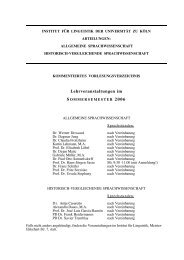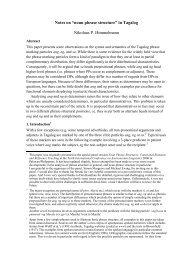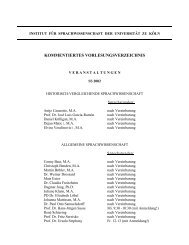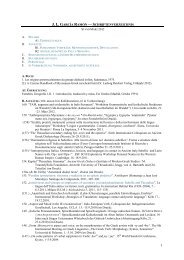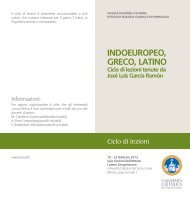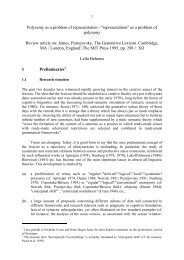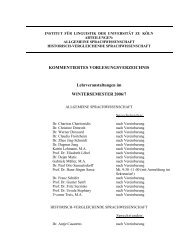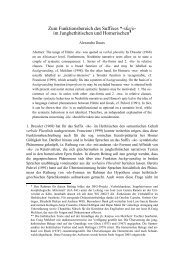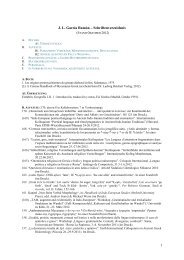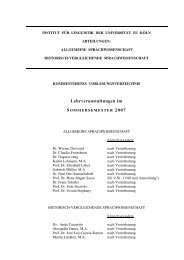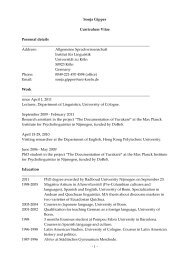Topics in Anatolian Historical Grammar Prof. Dr. H. Craig Melchert
Topics in Anatolian Historical Grammar Prof. Dr. H. Craig Melchert
Topics in Anatolian Historical Grammar Prof. Dr. H. Craig Melchert
Create successful ePaper yourself
Turn your PDF publications into a flip-book with our unique Google optimized e-Paper software.
Luvo-Lycian Dorsal Stops Revisited<br />
H. <strong>Craig</strong> <strong>Melchert</strong><br />
University of California, Los Angeles<br />
1. Introduction<br />
There is a broad consensus that at some prehistoric stage the Indo-European stop<br />
system had only a two-way phonological contrast of labialized velars<br />
(traditionally “labiovelars”) and non-labialized velars: thus schematically /K w /<br />
versus /K/. The latter had two conditioned allophones, palato-velars or front<br />
velars (traditionally “palatals”) <strong>in</strong> front<strong>in</strong>g environments and non-front velars<br />
(traditionally “velars”) elsewhere: [K j ] and [K]. Formulations of just what<br />
constituted a “front<strong>in</strong>g environment” can differ markedly (one may compare<br />
among many Meillet 1934: 94 and Lipp 2009: 1.7&53). Nevertheless, the highly<br />
skewed—that is, non-random and largely complementary—distribution of<br />
traditional “palatals” and “velars” strongly supports this fundamental premise.<br />
The major po<strong>in</strong>t of dispute for more than a century has been whether or not a<br />
partial loss of condition<strong>in</strong>g environment, analogy, and other factors led to a socalled<br />
phonemic split <strong>in</strong> PIE (that prehistoric stage that we reach by direct<br />
comparative reconstruction). The result would have been a three-way contrast<br />
/K j /, /K/ and /K w /, albeit very likely <strong>in</strong> a limited number of examples and with<br />
much of the previous complementary distribution preserved, as is typical for<br />
such splits. I contend that the answer to this question is yes, regardless of the<br />
facts of Luvo-Lycian (likewise Kümmel 2007: 312).<br />
The typological objection of Sihler (1995: 152-3) and Lipp (2009: 1.31 65 )<br />
that the presupposed back<strong>in</strong>g of palatal stops to velars <strong>in</strong> the “centum” languages<br />
is unattested is a straw man. There is no compell<strong>in</strong>g evidence that the PIE stops<br />
conventionally labeled “palatals” were true palatal stops (IPA [c] and [ɟ]).<br />
Evidence from all attested languages is fully compatible with front velars. 1<br />
There is <strong>in</strong> any case no necessity to assume that the phonological merger of /K j /<br />
and /K/ <strong>in</strong> the centum languages even took place by phonetic back<strong>in</strong>g of front<br />
velars. S<strong>in</strong>ce the place of articulation of /K/ <strong>in</strong> the older centum languages is<br />
<strong>in</strong>determ<strong>in</strong>ate, we may rather assume the more likely generalization of [K j ] <strong>in</strong><br />
front<strong>in</strong>g environments (along with other factors lead<strong>in</strong>g to an allophonic<br />
distribution).<br />
1 Compare Kümmel 2007: 318. I also regard as fully viable his alternative solution (2007:<br />
318-27) of an orig<strong>in</strong>al contrast of velar, uvular, and labialized velar stops.



